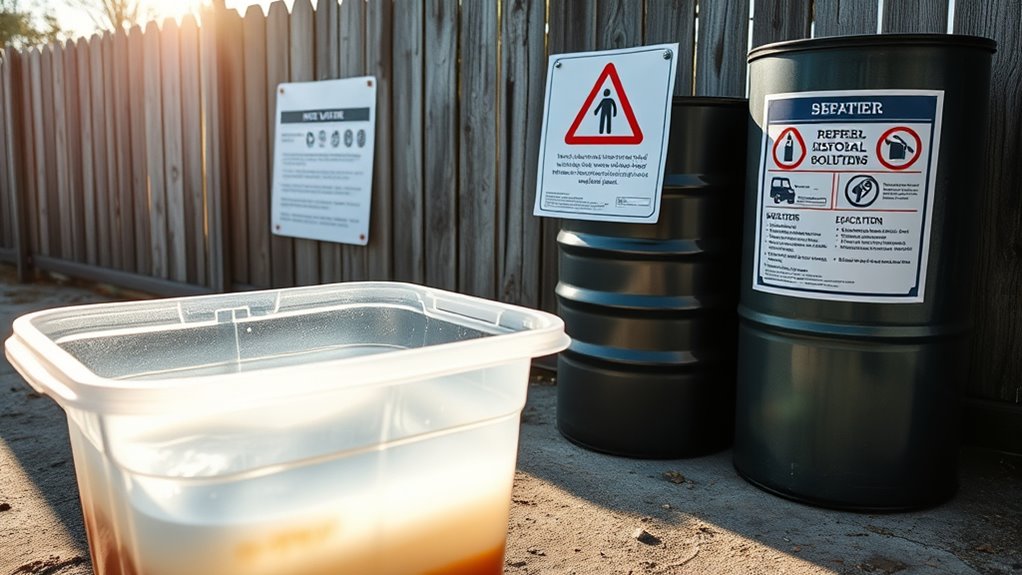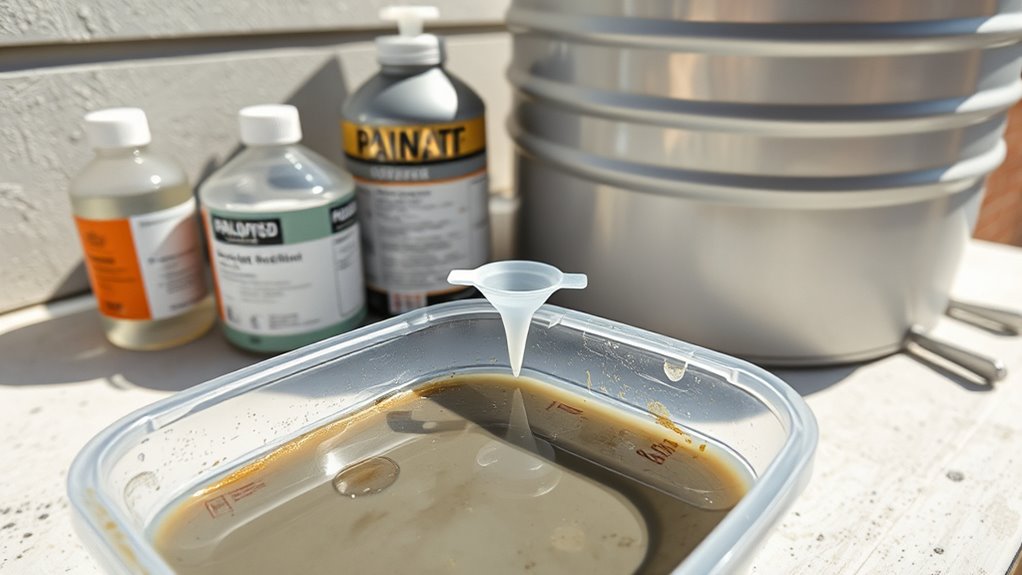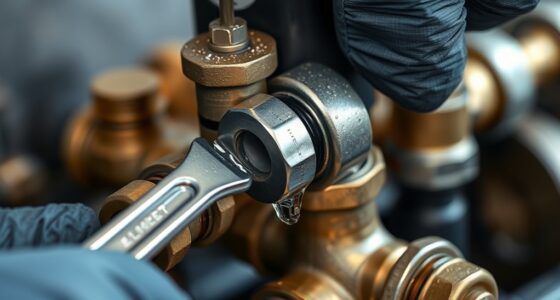To safely dispose of paint sprayer wastewater and solvents, you should first identify if they are hazardous waste and label the containers clearly. Store them securely in well-ventilated areas away from children and pets, using spill-proof containers for transportation. Always follow local regulations and consider recycling or on-site treatment if permitted. Using proper disposal methods defends the environment, wildlife, and water sources. Keep learning how to handle waste responsibly to ensure safety and compliance.
Key Takeaways
- Identify if the waste is hazardous and label containers clearly before disposal.
- Store waste in secure, leak-proof containers away from children and pets.
- Dispose of waste at authorized hazardous waste disposal sites following local regulations.
- Use PPE like gloves and goggles when handling or cleaning up paint sprayer waste.
- Consider recycling or on-site treatment options if permitted, to reduce environmental impact.

Cleaning up safely is vital to prevent injuries and guarantee the job gets done effectively. When dealing with paint sprayer waste water and solvents, it’s imperative to handle them responsibly, not just for your safety but also for the environment. Proper disposal is key to avoiding contamination and legal issues. Start by understanding that waste water from your paint sprayer contains residual paints, solvents, and chemicals that shouldn’t go straight into drains or onto the ground. Instead, you should collect this waste in designated containers designed for hazardous materials. Never pour it into storm drains, sewers, or onto soil, as this can harm wildlife, pollute water sources, and violate environmental regulations. Proper disposal means knowing your local regulations and following them carefully, which often involves taking waste to a licensed disposal facility.
Environmental safety should always be at the forefront of your cleanup process. Before disposing of any waste, double-check whether it’s classified as hazardous waste. If it is, you’ll need to label the containers clearly and store them in a secure, well-ventilated area away from children and pets. Consider using spill-proof containers to prevent leaks or accidental spills during transportation. When it’s time to dispose of the waste, do so at authorized disposal sites rather than dumping it in trash bins or leaving it unattended. These facilities are equipped to handle and process hazardous waste safely, minimizing environmental impact. If your local regulations allow, some solvents and waste water can be recycled or treated on-site, reducing your environmental footprint. Always consult safety data sheets (SDS) for specific disposal guidelines related to the products you’ve used.
Additionally, adopting best practices reduces the risk of spills and accidents. Use absorbent materials around containers to catch leaks, and clean your equipment thoroughly to prevent leftover chemicals from leaking out. Wearing personal protective equipment (PPE) like gloves and goggles during cleanup minimizes exposure to harmful substances. Remember, proper disposal isn’t just about avoiding fines — it’s about respecting your community, wildlife, and water sources. By taking the extra step to dispose of paint sprayer waste water and solvents correctly, you help protect the environment for everyone.
In recent technological advancements, AI integration in waste management can assist in monitoring and optimizing disposal procedures, ensuring compliance and safety. To sum up, handling waste responsibly, understanding proper disposal methods, and prioritizing environmental safety are the foundations of a safe and effective cleanup process. Doing so ensures your work is thorough, safe, and environmentally conscious.
Frequently Asked Questions
Can I Reuse Leftover Paint Sprayer Wastewater?
You might be able to reuse leftover paint sprayer wastewater if you perform proper paint recycling and wastewater filtration. First, filter out debris and solids to prevent clogs. Then, consider testing the wastewater for quality before reuse. Keep in mind, some paints contain hazardous chemicals, so always follow safety guidelines. Reusing wastewater can save resources, but confirm it’s clean enough to avoid affecting your new coating.
What Are the Legal Disposal Regulations in My Area?
Your question about legal disposal regulations contrasts local hazardous waste rules with the need for proper permits. You must check if your area mandates disposal permits for paint sprayer wastewater and solvents. Ignoring these rules risks fines or environmental harm. Contact your local waste management agency to verify regulations, ensuring you’re compliant. Proper disposal protects your community and the environment while keeping you on the right side of the law.
Are There Environmentally Friendly Solvents for Cleaning?
You might want to explore biodegradable solvents and eco-friendly cleaning agents for cleaning your paint sprayer. These alternatives break down more easily in the environment and reduce harmful chemical exposure. By choosing biodegradable options, you help protect waterways and ecosystems. Always check product labels for eco credentials, and consider using natural or plant-based solvents that are effective yet gentle on the environment, ensuring safer cleanup without compromising performance.
How Can I Prevent Spills During Disposal?
Spill prevention and disposal safety go hand in hand, like precision and caution. To prevent spills during disposal, you should use sealed containers and pour slowly to avoid splashing. Always work on stable surfaces and keep a spill kit nearby. Label containers clearly and avoid overfilling. By staying attentive and prepared, you reduce the risk of accidents, ensuring a safer environment for everyone involved in handling waste water and solvents.
What Protective Gear Is Recommended During Cleanup?
During cleanup, you should wear personal protective equipment to stay safe from harmful chemicals. Use cleaning gloves to protect your skin from paint residues and solvents. Consider wearing safety goggles to shield your eyes and a mask or respirator if fumes are strong. This gear helps prevent skin irritation, inhalation of fumes, and eye injuries, ensuring you handle waste water and solvents safely and effectively.
Conclusion
Now that you know how to properly dispose of paint sprayer waste water and solvents, you’re well on your way to a safer, cleaner workspace. Remember, safety should never be an afterthought—it’s better to be safe than sorry. By following these tips, you avoid unnecessary headaches and protect the environment. Don’t let the cleanup become a wild goose chase—stay responsible, stay informed, and keep everything running smoothly. Your efforts today make a cleaner tomorrow.
Franz came aboard the Paint Sprayer Zone team with a background in both journalism and home renovation. His articulate writing style, combined with a passion for DIY projects, makes him an invaluable asset. Franz has a knack for breaking down technical jargon into easy-to-understand content, ensuring that even the most novice of readers can grasp the complexities of paint sprayers.










